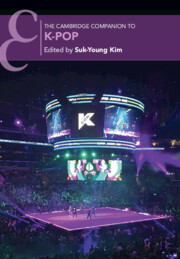Book contents
- The Cambridge Companion to K-Pop
- Cambridge Companions to Music
- The Cambridge Companion to K-Pop
- Copyright page
- Contents
- Figures
- Tables
- Contributors
- Acknowledgments
- Notes to Readers
- Introduction
- Part I Genealogies
- 1 Sticking It to the Man
- 2 Itaewon Class, Gangnam Style, and Yeouido Star
- Part II Sounding Out K-Pop
- Part III Dancing to K-Pop
- Part IV The Making of Idols
- Part V The Band That Surprised the World
- Part VI Circuits of K-Pop Flow
- Index
2 - Itaewon Class, Gangnam Style, and Yeouido Star
The Industrial Revolution of Korean Pop in the 1990s
from Part I - Genealogies
Published online by Cambridge University Press: 02 March 2023
- The Cambridge Companion to K-Pop
- Cambridge Companions to Music
- The Cambridge Companion to K-Pop
- Copyright page
- Contents
- Figures
- Tables
- Contributors
- Acknowledgments
- Notes to Readers
- Introduction
- Part I Genealogies
- 1 Sticking It to the Man
- 2 Itaewon Class, Gangnam Style, and Yeouido Star
- Part II Sounding Out K-Pop
- Part III Dancing to K-Pop
- Part IV The Making of Idols
- Part V The Band That Surprised the World
- Part VI Circuits of K-Pop Flow
- Index
Summary
This chapter focuses on so-called proto-K-pop, just prior to the birth of K-pop as exportable good in the late 1990s, and the subcultures based on nightclubs and discotheques from the mid-1980s to the early 1990s. The dancers and DJs who gathered at Seoul nightclubs (and in other cities) emulated dance and music from the United States, Europe, and Japan, and constructed their own “authentic” genre. In the late 1980s and early 1990s, dancers began their careers as backup for the established singers and gradually repositioned themselves as “dancers who sing.” During the same period, some DJs who became producers, managers, and songwriters successfully challenged the existing record industry. This chapter investigates the transformation of the small-scale and scattered subculture based in nightclubs into a lucrative business associated with the organized music industry. Three production-cum-management companies – SM (Hyun Jin-young and Wawa), Line (Kim Gun Mo), and Yoyo (Seo Taiji and Boys) – are closely examined. It is inevitable to contrast the rap/reggae/techno-oriented 1990s with the folk/rock/ballad-oriented 1980s. But this chapter eschews the dichotomy by showing the genre diversity consciously designed by the industry. It aims to show the ground zero of the so-called K-pop machine, without making any teleological assumptions.
- Type
- Chapter
- Information
- The Cambridge Companion to K-Pop , pp. 28 - 48Publisher: Cambridge University PressPrint publication year: 2023

